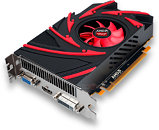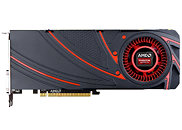Here's a quick recap of AMD's updated product stack, spread between the R9 and R7 series. This article can help you understand the new nomenclature. AMD's lineup begins with the Radeon R7 250 and Radeon R7 260X. The two are based on the 28 nm "Curacao" silicon, which is a variation of the "Pitcairn" silicon the previous-generation Radeon HD 7870 was based on. The R7 250 is expected to be priced around US $89, with 1 GB of RAM, and performance rated at over 2,000 points by 3DMark Firestrike benchmark. The R7 260X, features double the memory at 2 GB, higher clock speeds, possibly more number crunching resources, Firestrike score of over 3,700 points, and a pricing that's around $139. This card should turn up the heat against the likes of GeForce GTX 650 Ti Boost.
Moving on, there's the $199 Radeon R9 270X. Based on a chip not much unlike "Tahiti LE," it features 2 GB of memory, and 3DMark Firestrike score of over 5,500 points. Then there's the Radeon R9 280X. This card, priced attractively at $299, is practically a rebrand of the Radeon HD 7970 GHz Edition with. It features 3 GB of RAM, and over 6,800 points on 3DMark Firestrike. Then there are the R9 290 and R9 290X. AMD flew dozens of scribes thousands of miles over to Hawaii, and left them without an official announcement on the specifications of the two. Without knowing the true specifications on the "Hawaii" silicon, we can't speculate their specs. From what AMD told us, the two feature 4 GB of memory, over 5,000 TFLOP/s compute power, and over 300 GB/s memory bandwidth. The cards we mentioned are pictured in that order below.
http://www.techpowerup.com/191503/radeon-r9-and-radeon-r7-graphics-cards-pictured-some-more.html
Moving on, there's the $199 Radeon R9 270X. Based on a chip not much unlike "Tahiti LE," it features 2 GB of memory, and 3DMark Firestrike score of over 5,500 points. Then there's the Radeon R9 280X. This card, priced attractively at $299, is practically a rebrand of the Radeon HD 7970 GHz Edition with. It features 3 GB of RAM, and over 6,800 points on 3DMark Firestrike. Then there are the R9 290 and R9 290X. AMD flew dozens of scribes thousands of miles over to Hawaii, and left them without an official announcement on the specifications of the two. Without knowing the true specifications on the "Hawaii" silicon, we can't speculate their specs. From what AMD told us, the two feature 4 GB of memory, over 5,000 TFLOP/s compute power, and over 300 GB/s memory bandwidth. The cards we mentioned are pictured in that order below.
http://www.techpowerup.com/191503/radeon-r9-and-radeon-r7-graphics-cards-pictured-some-more.html







Комментариев нет:
Отправить комментарий